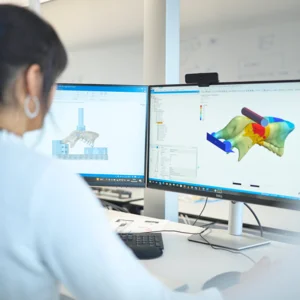PhD-Kandidatin Michaela Maintz entwickelt und testet neuartige Implantate aus dem 3D-Drucker
(For the English version please see below)
DE
Im 2. Stock des "Main Campus", am Department of Biomedical Engineering (DBE) der Universität Basel, ist die Zukunft der biomedizinischen Technologie mit Händen greifbar: Forschende entwickeln ultradünne Biosensoren, züchten Nervengewebe, bauen Geräte, die präzise Diagnosen allein aus einem Atemstoss gewinnen können, oder bringen Rechnern bei, selbständig die Wirkung von Medikamenten in medizinischen Bildern zu messen. PhD-Kandidatin Michaela Maintz entwickelt und testet neuartige Implantate aus dem 3D-Drucker, die dann einem Patienten oder einer Patientin am Universitätsspital Basel eingesetzt werden.
“Ich erstelle einen sogenannten digitalen Zwilling aus den Daten eines CT-Scans eines Patienten. An diesem Modell kann ich dann die Knochenimplantate designen und testen”, so die PhD Kandidatin. Ihre Simulationen zeigen präzise, an welchen Stellen das Implantat den stärksten Kräften standhalten und entsprechend angepasst werden muss. Darüber hinaus entwickelt sie eine Methode mit biomimetischen Algorithmen, die dem Knochenwachstum ähneln, um die Implantate automatisch strukturell anzupassen. Solche "smarten" Implantate sind sehr stabil, nicht grösser als nötig und perfekt an die individuelle Anatomie angepasst.
Maintz ist Teil der Projektgruppe Swiss Medical Additive Manufacturing. Das Team entwickelt Verfahren und Methoden, um Implantate im 3D-Drucker genau an die Bedürfnisse der betreffenden Person anzupassen. Sie sind dabei schneller, effektiver und günstiger als die bisherigen Verfahren und verringern zudem die Operationszeit – also die Arbeit am offenen Körper – deutlich.
In diesem Kontext stellt Maintz auch die Verbindung zum Kooperationspartner Fachhochschule Nordwestschweiz her, die durch Expertise in der Implantatentwicklung und Validierung unterstützend tätig ist. Zugleich ist ihre Arbeit auch Teil des MIRACLE-Projekts am DBE, das den 3D-Druck, Lasertechnologie, Robotik und virtuelle Realität in einem neuartigen, minimalinvasiven System für die Chirurgie vereint.
In den Projekten am DBE kommt keine Person und keine Disziplin im Alleingang weiter. Zusammenarbeit ist der Schlüssel zum Erfolg, weshalb auch die neue Nachbarschaft im «Main Campus» für Maintz spannend ist: “Wir haben grosse Firmen im Life Science- und Technikbereich in unmittelbarer Umgebung – das pusht, inspiriert und hilft auch der Vernetzung”. Der Innovationsgeist, den man auf dem BaseLink erfährt, macht neugierig. Hier ist die Zukunft der Medizin mit Händen greifbar und so kommen neue Ideen für interdisziplinäre Projekte manchmal in einer Pause oder bei einem Anlass auf dem Campus.
EN
About digital twins and "smart" implants
On the 2nd floor of the "Main Campus", at the Department of Biomedical Engineering (DBE) of the University of Basel, the future of biomedical technology is tangible: Researchers are developing ultra-thin biosensors, growing nerve tissue, building devices that can extract precise diagnoses from just a breath, or teaching computers to independently measure the effects of drugs in medical images. PhD candidate Michaela Maintz is developing and testing novel implants from the 3D printer that are then implanted in a patient at University Hospital Basel.
"I create a so-called digital twin from the data of a CT scan of a patient. I can then design and test the bone implants on this model," says the PhD candidate. Her simulations show precisely where the implant must withstand the strongest forces and be adjusted accordingly. She is also developing a method using biomimetic algorithms that resemble bone growth to automatically adjust implants structurally. Such "smart" implants are very stable, no larger than necessary and perfectly adapted to the individual anatomy.
Maintz is part of the Swiss Medical Additive Manufacturing project group. The team is developing processes and methods for adapting implants in the 3D printer precisely to the needs of the person in question. In doing so, they are faster, more effective and less expensive than previous methods and also significantly reduce surgery time. In this context, Maintz also establishes a connection with the cooperation partner University of Applied Sciences Northwestern Switzerland, which provides support through expertise in implant development and validation. At the same time, her work is also part of the MIRACLE project at the DBE, which combines 3D printing, laser technology, robotics and virtual reality in a novel, minimally invasive system for surgery.
In the projects at DBE, no one person or discipline gets anywhere on their own. Collaboration is the key to success, which is why the new neighbourhood in the "Main Campus" is also exciting for Maintz: "We have large companies in the life science and technology sectors in the immediate vicinity - that pushes, inspires and also helps networking." The spirit of innovation experienced at BaseLink arouses curiosity. Here, the future of medicine is tangible, and so new ideas for interdisciplinary projects sometimes come during a break or at an event on campus.
MIRACLE: https://dbe.unibas.ch/en/research/flagship-project-miracle/
DBE: https://dbe.unibas.ch/en/
3D Print Lab link: https://www.unispital-basel.ch/radiologie-nuklearmedizin/3dprintlab











